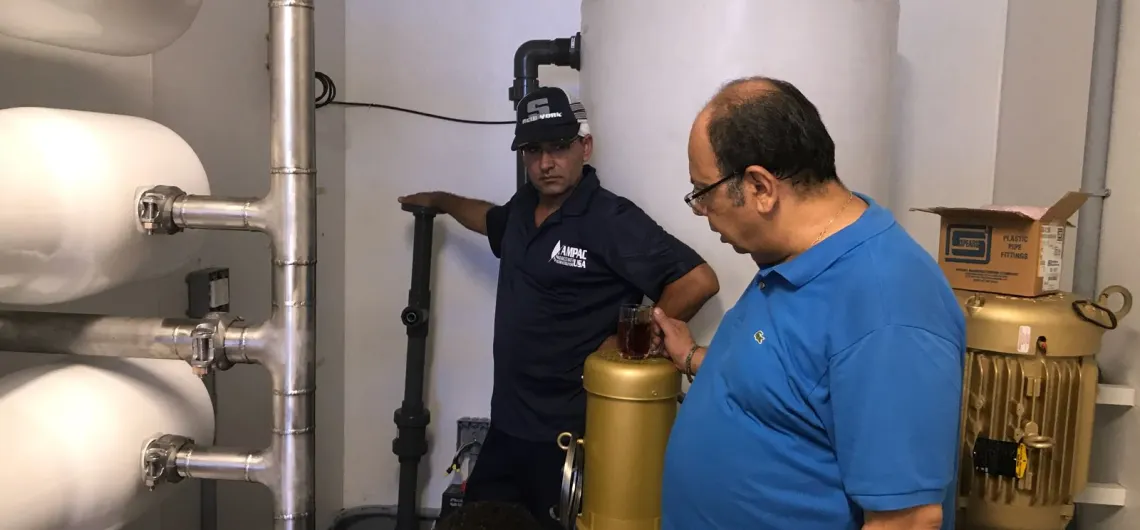Summary:
UN predicts that by 2050, 5 billion people around the world will be living in water-stressed areas. The need for better, economic and accessible technologies resurface each year with the increase in stress. One of the current solutions for providing freshwater, seawater desalination, even though effective, needs advancements that can make it more efficient and economic to be used for masses around the world. This article looks at heat composites as a possible solution in making the process effective and a polymer composite as a possible alternative.
Description:
Seawater desalination is basically differentiating salt and chemicals from seawater. It is the filtration process through which populations across the world get drinking water despite the low availability of freshwater resources. These plants which are all around the world, use one of the two major ways of desalinating water, Reverse Osmosis or Distillation. Where on one side reverse osmosis is far more advanced and effective, distillation is a traditional method that uses only energy as a major requirement.
Reverse Osmosis is a technique of pushing saline water through a semi-permeable membrane to get pure water on the other side. This requires a lot of work in terms of treatment of water, maintenance of membranes etc. Distillation, on the other hand, is a simple boiling of water to a point where the pure water vapors go up to the condensing chamber and thus giving streams of pure water. These are the two major types of seawater desalination that are being used all around the world and none of the other processes have proven to be close enough to filter a large quantity of water with effectiveness.
Heat Composites for Seawater Desalination
However, long back in 2012, another such process was recommended which involved heat composites. This method is used in some countries even today that includes Spain and Portugal. These countries face acute water shortage every year and so depend on seawater desalination to make water available. The method they use includes the planting of heat composite pipes in the desalination chambers. Here is how the process works.
The Process
Seawater is sprayed on the composite pipes which are made hot by passing hot gas or water through them. Because of the increased temperature, the water from the seawater is converted into vapor then sent in condensing chambers. What is left behind is a sludge of salts full of chemicals and unwanted substances. For this method to be effective, the pipes need to be strong and have properties that satisfy the points below:
- The pipes must be heated conducive, able to withstand temperatures required to evaporate water.
- They must be corrosion resistant because the sludge of salt will be deposited on the pipes every time the process happens.
- They must be durable and effective for a long time reducing maintenance time and costs.
- It must be easily coated with seawater.
The Alternative
Due to the high demands of the properties of these pipes, titanium or alloy forms of steel were used before. But because these materials are not easily available, the prices rose tremendously and the availability decreased with every year. To turn this challenge into an opportunity, scientists at Fraunhofer IFAM, Bremen, Germany came up with a polymer composite alternative for the same.
The advantage they obtained here is: the polymer was heat-conducive despite being of plastic nature and could be built in continuous measures. The heat conductivity was easily achieved by introducing metal particles in the polymer. Around 50% of copper microfibers were included to make the polymer conduct heat. After building the composite another important challenge was to improve its thermal conductivity. To do this, a series of tests were carried out to check the amount of sludge formed, the temperature of the hot gas was kept at 70 degree Celsius.
On the basis of the amount of corrosion, the composite properties were then optimized to decrease the amount of salty sludge formation. In the results found, it was noted that fewer amounts of leftovers were found on the composite, corrosion was less and the pressure difference in and out of the pipe wasn’t that much.
Possible Applications
The composite built doesn’t have its applications limited to just seawater desalination but also pharmaceutical and food industries. The composites show promise in seawater desalination but haven’t yet been used on a larger scale except for in a few countries. The reverse osmosis process has in time proved to be a far more effective method of water filtration which is why companies and desalination plants around the world, almost a good majority of them, use it as the central process.
Water is a commodity no one around the world can afford to lose on. With more severe droughts each year, it is getting difficult to provide drinking water to the population. Water crisis threatens to affect billions by 2050 according to the reports from the UN. We, therefore, must keep in mind and develop technologies that make use of the potential of seawater in any way possible.
Author’s Bio:
Ampac USA is a leading manufacturer of advanced reverse osmosis water treatment systems. For over 30 years the company has been providing its customers and clients around the world solutions to their water treatment problems. With years of an impressive track record, Ampac strives to develop solutions to make reverse osmosis systems, advanced for improved quality and cost efficiency.
References:
- https://www.materialstoday.com/surface-science/news/heat-conducting-composites-for-seawater/
- https://www.sciencedaily.com/releases/2012/10/121004093245.htm
- https://www.designnews.com/materials-assembly/composite-conducts-heat-remove-salt-seawater/7906506032374
- https://www.theguardian.com/environment/2018/mar/19/water-shortages-could-affect-5bn-people-by-2050-un-report-warns









